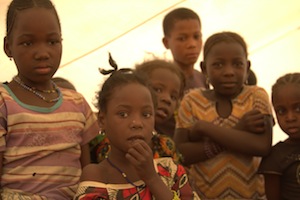Thursday, April 25, 2024
News and Views from the Global South
Child Soldiers Used in Mali Conflict
- It was tough for Hassan Toure to decide to stay in his small town on the outskirts of Kidal, in northern Mali. The government troops had withdrawn on Mar. 30, and several armed groups, including militias and bandits, were operating in the region.

Child combatants had been seen in the ranks of the Tuareg rebels in Mali. Credit: William Lloyd-George/IPS
“I wanted to leave for my children’s sake,” says Toure, speaking over the phone to IPS, and withholding his real name because he fears reprisals. “But my shop is the only thing I own, and I couldn’t let it be looted and destroyed by the thugs.”
Toure regrets the decision now.
He says that he tried to prevent his children from going outside at all, “but they’re at that age.” On Mar. 29, he says, his eldest son, 15, never came home, and is still missing.
“Other kids in the neighbourhood say he went with some armed men,” says Toure. “I cannot sleep. I am so worried about what might happen to him with those men.”
While Toure’s story, like most reports from the north of Mali, is difficult to confirm, his fears could be very real.
According to Corinne Dufka, a senior West Africa researcher for Human Rights Watch (HRW) who conducted a 10-day fact- finding mission to Mali in April, all the witnesses her organisation interviewed had reported seeing child soldiers in the rebel ranks.
Child combatants had been seen in the ranks of the Tuareg rebels, namely the Movement for the National Liberation of Azawaad (MNLA).
According to a HRW report titled “Mali – War Crimes by Northern Rebels”, released on Apr. 30, “many (children) were described as carrying military assault rifles and wearing fatigues that some people said were falling off their bodies.”
“The presence of children within the ranks of armed groups in northern Mali is a very disturbing development,” says Dufka.
“Commanders of these groups should immediately cease their recruitment of anyone under 18, release all the children from their forces, and work with child protection agencies to return them to their homes where they belong.”
Witnesses told HRW that child combatants appeared to be between 15 and 17 years old; however, some appeared to be as young as 12. Teachers from the region also told HRW that they recognised some of their students in the MNLA’s ranks.
Tuareg rebels, under several different names, have been fighting against the Malian state since its independence in 1960. Due to the political instability in Bamako where a Mar. 22 coup d’état toppled the government of President Amadou Toumani Touré, and an influx of weapons from Libya, the rebels managed to sweep across the north of Mali and announce a new state, Azawad, on Apr. 6.
This may have been slightly premature. Reports suggest that they are far from being in control of the situation and are competing with several Islamist groups in the region.
One group, Ansar Dine, led by former Tuareg rebel leader Iyad Ag Ghali, has expressed his group’s desire to apply Sharia law in the region. Ansar Dine does not want independence, but rather to establish an Islamic state.
Witnesses told HRW that they have seen fewer child soldiers in their ranks, but were concerned about Ansar Dine’s new wave of recruitment in the northern Malian regions of Gao, Dire and Niafounke in mid-April. It is reported that children have already been recruited and trained by Ansar Dine in camps outside of Gao.
Adding to concerns about the future of northern Mali are growing reports of foreign Islamist groups increasingly operating in the region. While they have long had a presence in the region, it is only recently they have been able to take advantage of the power vacuum and openly move around.
According to reports, the Nigerian Islamist group, Boko Haram, as well the regional Al-Qaeda group, the Al-Qaeda Organisation in the Islamic Maghreb, and its offshoot, the Movement for Unity and Jihad in West Africa (MUJAO), are all currently present in the north of Mali. They are also reported to be using child soldiers.
On Apr. 6, armed men stormed the Algerian consulate in Gao, kidnapping the consul and six staff members. According to an MNLA source, Boko Haram and MUJAO members had kidnapped them.
When the MNLA tried to rescue the diplomats, the joint Boko Haram-MUJAO force sent five young boys aged between 10 to12, with explosives strapped to their chests, to deter them.
The source says that the MNLA were told that if they did not leave, the young boys would blow everyone up. In response, the MNLA withdrew.
In addition to the inclusion of children in rebel ranks, HRW has reported numerous incidents of young girls being abducted and sexually abused. Witnesses say the MNLA has been taking girls as young as 12 to abandoned buildings and repeatedly raping them over the course of several days.
“We’re very concerned about what appears to be a drastic increase in the targeting and sexual abuse of women and girls by armed groups in the north,” says Dufka.
The vulnerability of women in the north is increased by the lack of medical care, non-existent rule of law, and limited humanitarian assistance.
The United Nations Office of Humanitarian Affairs estimates that since January 2012, at least 284,000 people have fled their homes as a result of the armed conflict in the north. Of this number, about 107,000 are believed to be internally displaced, while the rest have fled to neighbouring countries, notably Niger, Burkina Faso, Algeria and Mauritania.

 Print
Print



